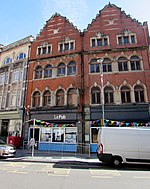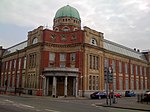Newport Castle
Archaeological sites in Newport, WalesCastle ruins in WalesCastles in Newport, WalesGrade II* listed buildings in Newport, WalesGrade II* listed castles in Wales ... and 4 more
History of Newport, WalesLandmarks in Newport, WalesTourist attractions in Newport, WalesUse British English from May 2015

Newport Castle (Welsh: Castell Casnewydd) is a ruined castle in Newport, Wales. It was built in the 14th century, probably by Hugh de Audley, 1st Earl of Gloucester or his son-in-law, Ralph, Earl of Stafford, with the purpose of managing the crossing of the River Usk. The castle was used as administrative offices for the collection of rent and dues from local tenants, and was also a residence and a garrison. In 1402 it was sacked by Owain Glyndŵr. It was in disrepair by 1522, and was taken by Oliver Cromwell's forces during the Civil War. Its use declined further in later centuries. It has been a Grade II* Listed building since 1951.
Excerpt from the Wikipedia article Newport Castle (License: CC BY-SA 3.0, Authors, Images).Newport Castle
Newport Bridge, Newport Baneswell
Geographical coordinates (GPS) Address Nearby Places Show on map
Geographical coordinates (GPS)
| Latitude | Longitude |
|---|---|
| N 51.5906 ° | E -2.995 ° |
Address
Newport Bridge
NP20 1DA Newport, Baneswell
Wales, United Kingdom
Open on Google Maps










